Brother CS-8120, CS-8130 Operation Manual
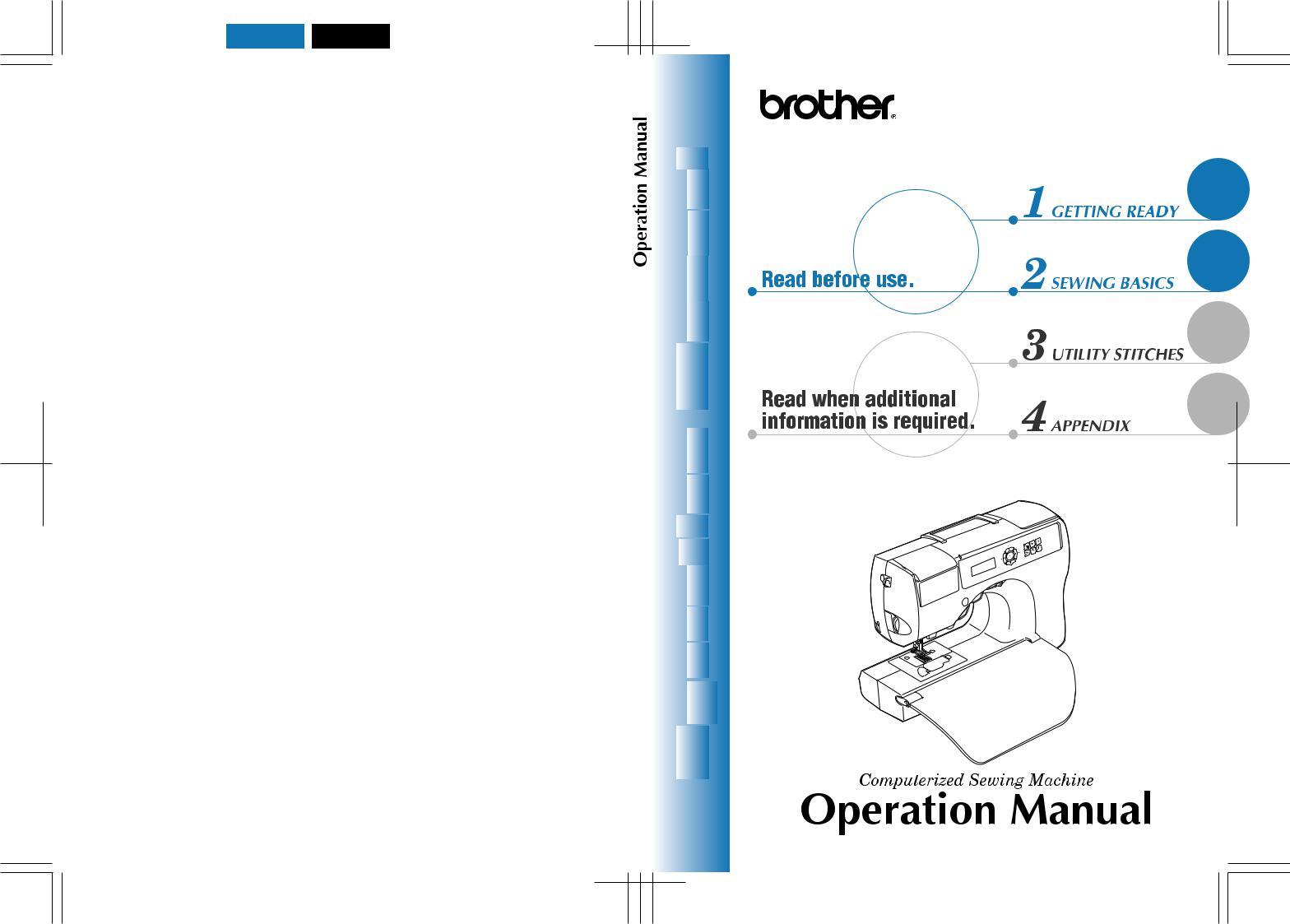
S3_BrotherE_cover DIC181p K
English
885-S08
XC5252-021
Printed in China
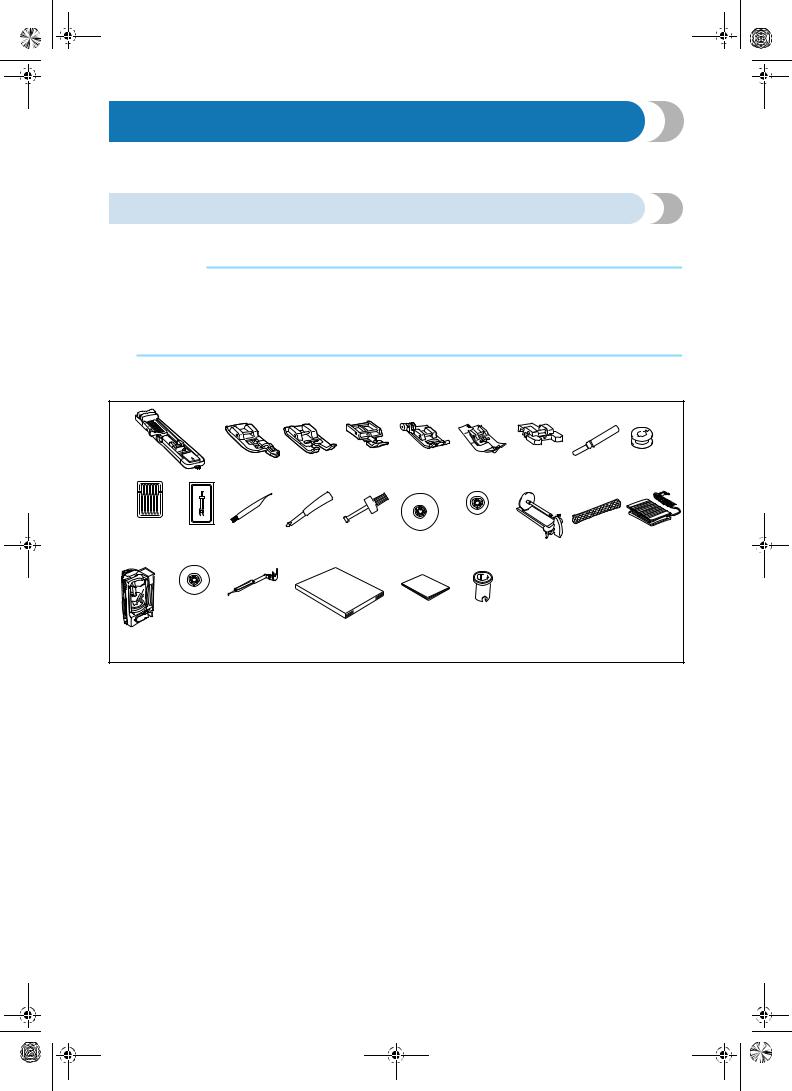
S3_brotherE.book Page A Wednesday, February 12, 2003 11:49 AM
Enclosed Accessories
After opening the box, check that the following accessories are enclosed. If any item is missing or damaged, contact your retailer.
Accessories
 Note
Note
(For U.S.A. only)
●Foot controller: Model N5V
This foot controller can be used on this machine model CS-8150.
●The screw of the presser foot holder is available through your authorized dealer. (Part code: XA4813-051)
1. |
2. |
3. |
4. |
5. |
6. |
7. |
8. |
9. |
10.* |
11. |
12. |
13. |
14. |
15. |
16. |
17. |
18. |
19. |
20. |
21. |
22. |
23. |
24. |
25. |
*75/11 2 needles 90/14 2 needles
90/14 2 needles: Ball point needle (gold colored)
No. |
Part Name |
Part Code |
No. |
Part Name |
Part Code |
|||
U.S.A. |
Others |
U.S.A. |
Others |
|||||
|
|
|
|
|||||
1 |
Buttonhole foot “A” |
XC2691-051 |
14 |
Screwdriver |
XC4237-021 |
|||
2 |
Overcasting foot “G” |
XC3098-051 |
15 |
Spool cap (large) |
130012-054 |
|||
3 |
Monogramming foot “N” |
X53840-351 |
16 |
Spool cap (small) |
130013-154 |
|||
4 |
Zipper foot “I” |
X59370-051 |
17 |
Extra spool pin |
XC3834-021 |
|||
5 |
Zigzag foot “J” (on machine) |
XC3021-051 |
18 |
Spool net |
XA5523-050 |
|||
6 |
Blind stitch foot “R” |
XC4051-051 |
19 |
Foot controller |
XC1154-021 |
|||
7 |
Button fitting foot “M” |
X59375-151 |
20 |
Thread cassette (on machine) |
XC3664-021 |
|||
8 |
Seam ripper |
X54243-001 |
21 |
Spool cap (orange) |
XC3673-021 |
|||
(on machine) |
||||||||
|
|
|
|
|
|
|
||
9 |
Bobbin (4) |
SA156 |
XA5539-151 |
22 |
Needle-changing tool |
XC4551-021 |
||
10 |
Needle set |
X58358-051 |
23 |
Operation manual |
XC5252-021 |
|||
11 |
Twin needle |
X59296-051 |
24 |
Quick reference guide |
XC5256-021, |
|||
XC5257-021 |
||||||||
|
|
|
|
|
|
|||
12 |
Cleaning brush |
X59476-051 |
25 |
Spool cap (special) |
XA5752-021 |
|||
13 |
Eyelet punch |
135793-051 |
|
|
|
|
||
Cover A

S3_brotherE.book Page B Wednesday, February 12, 2003 11:49 AM
Names of Machine Parts and Their Functions
The names of the various parts of the sewing machine and their functions are described below. Before using the sewing machine, carefully read these descriptions to learn the names of the machine parts.
Front view
1
2
3
4
5
6
7
1 Thread cassette compartment cover
2 Thread cassette compartment
Insert a thread cassette into the thread cassette compartment.
3Thread cassette eject lever
Press this lever to eject the installed thread cassette.
4Thread tension dial
Use the thread tension dial to adjust the tension of the upper thread.
5Thread cutter
Pass the threads through the thread cutter to cut them.
6 Arm
7Flap
Use the flap to create a table. When the sewing machine is not being used, store the machine with the flap folded up. Remove the flap to sew cylindrical pieces such as sleeve cuffs.
8 Sliding leg
Pull out the sliding leg during free-arm sewing.
E
D
C
B
A
?
9
8
9Operation buttons
Use the operation buttons to start the sewing machine and raise and lower the needle. (page Cover D)
0Operation panel
Select a stitch from those that appear in the operation panel. (page Cover E)
ABobbin winder
Use the bobbin winder when winding the bobbin.
BBobbin thread spool pin
Place the spool of thread for the bobbin onto this spool pin in order to wind the bobbin.
CBobbin storage compartment
Store the bobbins designed specifically for this sewing machine in this compartment.
DBobbin winder cover
Open this cover when winding the bobbin.
EThread guide for bobbin winding
Pass the thread around this thread guide when winding the bobbin thread.
Cover B

S3_brotherE.book Page C Wednesday, February 12, 2003 11:49 AM
———————————————————————————————————————— Names of Machine Parts and Their Functions
Needle and presser foot section
1
7 |
|
6 |
5 |
|
2 |
3
4
1Buttonhole lever
Lower the buttonhole lever when sewing buttonholes and bar tacks.
2Needle bar thread hook
Pass the upper thread through the needle bar thread hook.
3Needle plate
The needle plate is marked with guides for sewing straight seams.
4Bobbin cover/shuttle
Remove the bobbin cover, and then insert the bobbin into the shuttle.
5Feed dogs
The feed dogs feed the fabric in the sewing direction.
6Presser foot
The presser foot applies pressure consistently on the fabric as the sewing takes place. Attach the appropriate presser foot for the selected stitching.
7Presser foot holder
The presser foot is installed onto the presser foot holder.
Right-side/rear view
1
2
3
7
4 6
5
1Handle
Carry the sewing machine by its handle when transporting the machine.
2Balance wheel
Turn the balance wheel toward you to raise and lower the needle to sew one stitch.
3Main power switch
Use the main power switch to turn the sewing machine on and off.
4Power supply jack
Insert the plug on the power supply cord into the power supply jack.
5Foot controller jack
Insert the plug on the end of the foot controller cable into the foot controller jack.
6Air vent
The air vent allows the air surrounding the motor to be exchanged. Do not cover the air vent while the sewing machine is being used.
7Feed dog position switch
Use the feed dog position switch to lower the feed dogs.
 Memo
Memo
●Refer to Cover B, D or E pages while you are learning to use your machine.
Cover C

S3_brotherE.book Page D Wednesday, February 12, 2003 11:49 AM
Operation buttons
The operation buttons help you to easily perform various basic sewing machine operations.
1
2 |
|
3 |
7 |
|
6
5
4
1Thread cassette indicator
The indicator lights up or goes off depending on the
condition of the sewing machine.
Green: |
A thread cassette can be inserted. |
Red: |
A thread cassette cannot be inserted. |
Off: |
The sewing machine has been turned off |
|
or a thread cassette is already inserted. |
2Thread cutter button  (Only for models equipped with the thread cutter button)
(Only for models equipped with the thread cutter button)
Press the thread cutter button after stopping sewing to cut both the upper and the bobbin threads. For details, refer to “Cutting the thread” (page 55).
3Needle position button 
Press the needle position button to raise or lower the needle. Pressing the button twice sews one stitch.
4Start/stop button 
Press the start/stop button to start or stop sewing. The machine sews at a slow speed at the beginning of sewing while the button is depressed. When sewing is stopped, the needle is lowered in the fabric. For details, refer to “Starting to sew” (page 51).
5Presser foot lever
Raise and lower the presser foot lever to raise and lower the presser foot.
6Reverse/reinforcement stitch button 
Press the reverse/reinforcement stitch button to sew reverse stitches or reinforcement stitches. Reverse stitches are sewn by keeping the button pressed down to sew in the opposite direction. Reinforcement stitches are sewn by sewing 3 to 5 stitches on top of each other. For details, refer to “Securing the stitching” (page 53).
7Sewing speed controller
Slide the sewing speed controller to adjust the sewing speed.

 CAUTION
CAUTION
●Do not press the thread cutter button after the threads have already been cut, otherwise the needle may break, the threads may become tangled or damage to the machine may occur.
 Note
Note
●Do not press the thread cutter button if there is no fabric under the presser foot or while the machine is sewing, otherwise damage to the machine may occur.
●When cutting thread thicker than #30, nylon thread or other special threads, use the thread cutter on the side of the machine. For details, refer to “Cutting the thread” (page 55).
Cover D
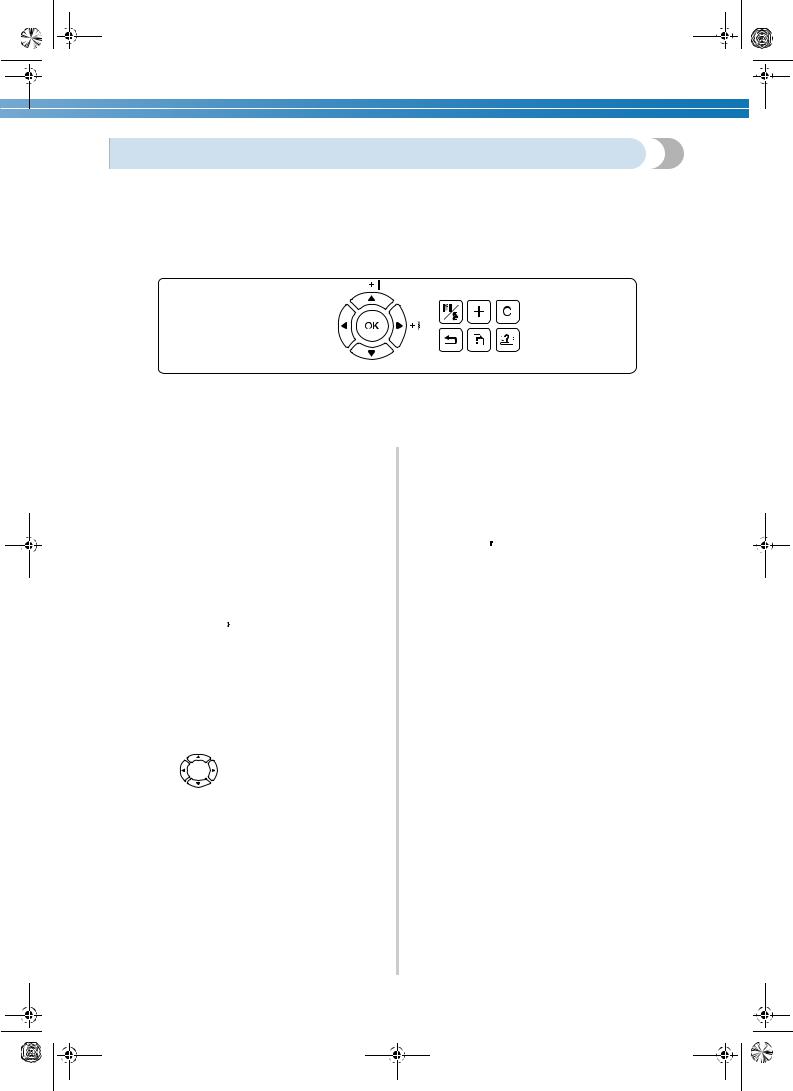
S3_brotherE.book Page E Wednesday, February 12, 2003 11:49 AM
Operation panel
The operation panel, located on the front of the sewing machine, consists of the LCD (liquid crystal display) and keys for specifying various sewing settings.
1 |
7 |
3 |
4 |
5 |
|||||||||
|
|
|
|
|
|
|
|
|
|
|
|
|
|
|
|
|
|
|
|
|
|
|
|
|
|
|
|
|
|
|
|
|
|
|
|
|
|
|
|
|
|
|
|
|
|
|
|
|
|
|
|
|
|
|
|
|
|
|
|
|
|
|
|
|
|
|
|
|
|
|
|
|
|
|
|
|
|
|
|
|
|
|
|
|
|
|
|
|
|
|
|
|
|
|
|
|
|
|
|
|
|
|
|
|
|
|
|
|
|
|
|
|
|
|
|
|
|
|
|
|
|
|
|
|
|
|
|
|
|
|
|
|
|
|
|
|
|
|
|
|
|
|
|
|
|
|
|
|
|
|
|
|
|
|
|
|
|
|
|
|
|
|
|
|
|
|
|
6 |
8 |
9 |
2 |
1LCD (liquid crystal display)
Settings for the selected stitch and error messages for incorrect operations appear in the LCD. Use keys 2 through 9, described below, to display various items and select the settings. For details, refer to “Understanding the LCD Screens” (page 12).
2Sewing machine help key 
Press this key to display operation information. Simple descriptions on threading the upper thread, installing the bobbin, winding the bobbin and replacing the presser foot can be displayed.
3Stitch selection key 
Press this key to select the desired type of stitch.
4  key
key
Press this key to add a pattern when sewing combinations of decorative stitches.
5  key
key
Press this key to remove an added pattern when sewing combinations of decorative stitches.
6Arrow keys
Use these keys to move in the indicated direction when
selecting an item displayed on the screen. In addition,

 can be pressed to select a lower setting and
can be pressed to select a lower setting and

 can be pressed to select a higher setting.
can be pressed to select a higher setting.
7OK key
Press this key to apply the selected item.
8Back key
Press this key to return to the previous screen.
9Settings key
Press this key to select sewing settings, such as for automatic reverse/reinforcement stitching, or other settings such as the operation beep.
Cover E

S3_brotherE.book Page 1 Wednesday, February 12, 2003 11:49 AM
———————————————————————————————————————————————————Enclosed Accessories
Optional Accessories
The following are available as optional accessories.
1. |
2. |
3. |
4. |
5. |
1.Side cutter
Part code: SA177, XC3879-002
2.Quilting guide
Part code: SA132, XC2215-002
3.Guide foot
Part code: SA133, XC1957-002
4.Walking foot
Part code: SA140, XC2214-002
5.Quilting foot
Part code: SA129, XC1948-002
 Memo
Memo
●To obtain optional accessories or parts, contact your sales representative or the nearest authorized service center.
1
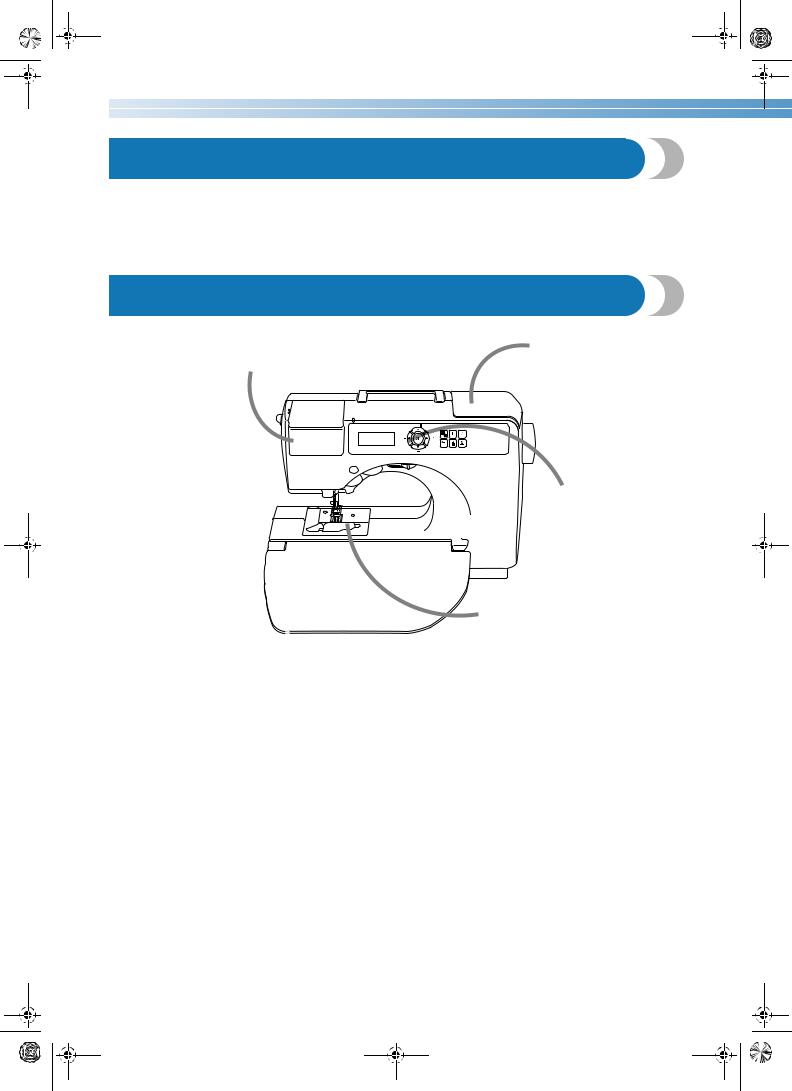
S3_brotherE.book Page 2 Wednesday, February 12, 2003 11:49 AM
Introduction
Thank you for purchasing this sewing machine.
Before using this sewing machine, carefully read the “Important Safety Instructions” (page 6), and then study this manual for the correct operation of the various functions.
In addition, after you have finished reading this manual, store it where it can quickly be accessed for future reference.
Sewing Machine Features
2
1
3
4
1Thread cassette
Easily thread the upper thread by loading a spool of thread into the thread cassette. In addition, simply insert the thread cassette into the compartment to thread the needle. (page 25)
2Simple bobbin-winding
The bobbin can quickly and easily be wound with thread. (page 18)
3Built-in stitches
You can select from the built-in stitches available, including utility stitches and decorative stitches. (page 66)
4One-touch lower threading
You can start sewing without pulling up the bobbin thread. (page 22)
2
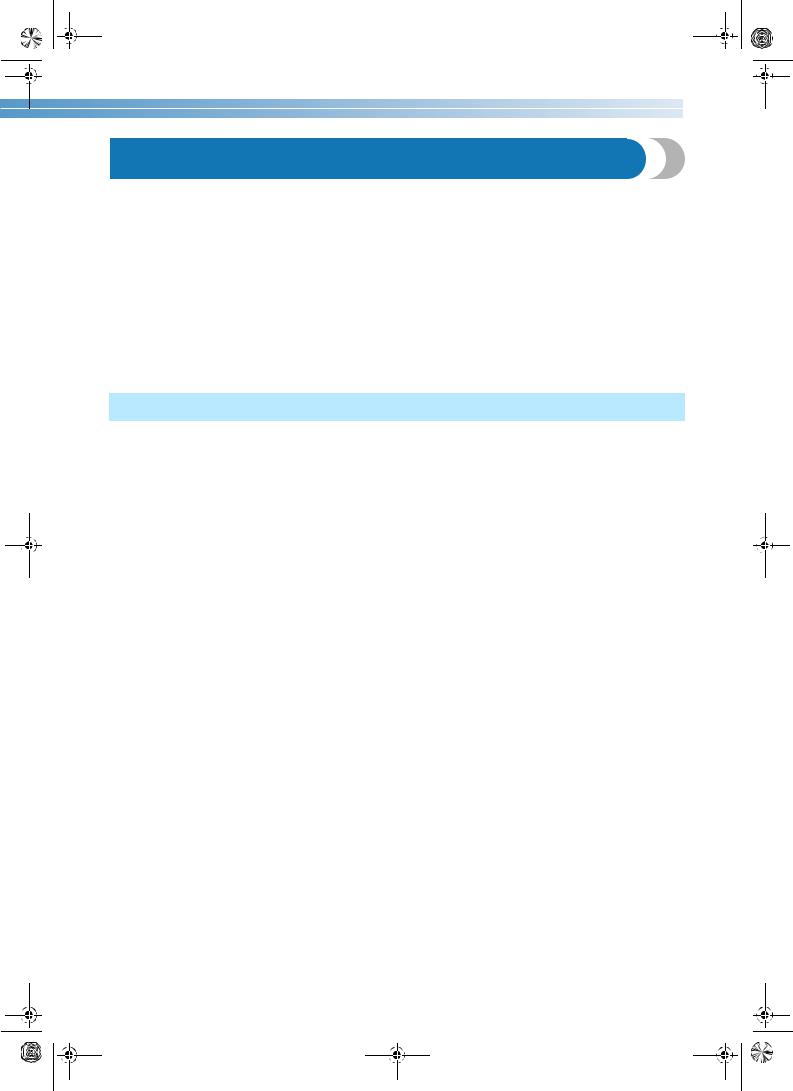
S3_brotherE.book Page 3 Wednesday, February 12, 2003 11:49 AM
Contents |
|
Enclosed Accessories ................................................................................................ |
Cover A |
Accessories ............................................................................................................................................. |
Cover A |
Names of Machine Parts and Their Functions .......................................................... |
Cover B |
Front view ............................................................................................................................................... |
Cover B |
Needle and presser foot section .............................................................................................................. |
Cover C |
Right-side/rear view ................................................................................................................................ |
Cover C |
Operation buttons .................................................................................................................................. |
Cover D |
Operation panel ...................................................................................................................................... |
Cover E |
Optional Accessories ........................................................................................................... |
1 |
Introduction ........................................................................................................................ |
2 |
Sewing Machine Features .................................................................................................... |
2 |
Contents .............................................................................................................................. |
3 |
Important Safety Instructions .............................................................................................. |
6 |
GETTING READY .............................................................................................. |
9 |
Turning the Machine On/Off ............................................................................................. |
10 |
Power supply precautions ............................................................................................................................... |
10 |
Turning on the machine .................................................................................................................................. |
11 |
Turning off the machine .................................................................................................................................. |
11 |
Understanding the LCD Screens ........................................................................................ |
12 |
Checking machine operating procedures ........................................................................................................ |
13 |
Changing the Machine Settings ......................................................................................... |
14 |
Changing the settings ...................................................................................................................................... |
14 |
Changing the needle stop position .................................................................................................................. |
16 |
Adjusting the brightness of the LCD ................................................................................................................ |
16 |
Changing the screen language ......................................................................................................................... |
17 |
Winding/Installing the Bobbin ........................................................................................... |
18 |
Bobbin precautions ......................................................................................................................................... |
18 |
Winding the bobbin ........................................................................................................................................ |
18 |
Installing the bobbin ....................................................................................................................................... |
22 |
Upper Threading ............................................................................................................... |
24 |
About the spool of thread ................................................................................................................................ |
24 |
Loading the spool into the thread cassette ....................................................................................................... |
25 |
Threading the needle ...................................................................................................................................... |
28 |
Using the extra spool pin ................................................................................................................................ |
30 |
Thread the needle manually (without using the needle threader) ..................................................................... |
31 |
Using the twin needle ..................................................................................................................................... |
32 |
Pulling up the bobbin thread ........................................................................................................................... |
35 |
Replacing the Needle ........................................................................................................ |
36 |
Needle precautions ......................................................................................................................................... |
36 |
Needle types and their uses ............................................................................................................................. |
36 |
Checking the needle ....................................................................................................................................... |
37 |
Replacing the needle ....................................................................................................................................... |
38 |
Replacing the Presser Foot ................................................................................................ |
41 |
Presser foot precautions .................................................................................................................................. |
41 |
Replacing the presser foot ............................................................................................................................... |
41 |
Removing the presser foot holder .................................................................................................................... |
43 |
Using the optional walking foot ...................................................................................................................... |
44 |
Sewing Cylindrical Pieces .................................................................................................. |
46 |
Free-arm sewing .............................................................................................................................................. |
46 |
3

S3_brotherE.book Page 4 Wednesday, February 12, 2003 11:49 AM
—————————————————————————————————————————————————————————————— |
SEWING BASICS ............................................................................................. |
47 |
Sewing ............................................................................................................................... |
48 |
General sewing procedure .............................................................................................................................. |
49 |
Positioning the fabric ...................................................................................................................................... |
50 |
Starting to sew ................................................................................................................................................. |
51 |
Securing the stitching ...................................................................................................................................... |
53 |
Cutting the thread ........................................................................................................................................... |
55 |
Adjusting the Thread Tension ............................................................................................ |
56 |
Changing the tension of the upper thread ........................................................................................................ |
56 |
Adjusting the Stitch Width and Length .............................................................................. |
57 |
Adjusting the stitch width ................................................................................................................................ |
57 |
Adjusting the stitch length ............................................................................................................................... |
58 |
Useful Functions ................................................................................................................ |
59 |
Automatically sewing reverse/reinforcement stitches ....................................................................................... |
59 |
Useful Sewing Tips ............................................................................................................ |
61 |
Trial sewing .................................................................................................................................................... |
61 |
Changing the sewing direction ........................................................................................................................ |
61 |
Sewing curves ................................................................................................................................................. |
61 |
Sewing thick fabrics ........................................................................................................................................ |
62 |
Sewing thin fabrics .......................................................................................................................................... |
63 |
Sewing stretch fabrics ...................................................................................................................................... |
63 |
Sewing an even seam allowance ..................................................................................................................... |
63 |
UTILITY STITCHES .......................................................................................... |
65 |
Selecting Stitching ............................................................................................................. |
66 |
Stitch types ...................................................................................................................................................... |
66 |
Selecting stitching ........................................................................................................................................... |
66 |
Overcasting Stitches .......................................................................................................... |
68 |
Sewing overcasting stitches using overcasting foot “G” ................................................................................... |
68 |
Sewing overcasting stitches using zigzag foot “J” ............................................................................................. |
69 |
Sewing overcasting stitches using the optional side cutter ............................................................................... |
70 |
Basic Stitching ................................................................................................................... |
72 |
Basting ............................................................................................................................................................ |
72 |
Basic stitching ................................................................................................................................................. |
72 |
Blind Hem Stitching .......................................................................................................... |
74 |
Buttonhole Stitching .......................................................................................................... |
76 |
Buttonhole sewing .......................................................................................................................................... |
77 |
Button sewing ................................................................................................................................................. |
80 |
Zipper Insertion ................................................................................................................. |
82 |
Inserting a centered zipper .............................................................................................................................. |
82 |
Inserting a side zipper ..................................................................................................................................... |
83 |
Sewing Stretch Fabrics and Elastic Tape ............................................................................ |
86 |
Stretch stitching ............................................................................................................................................... |
86 |
Elastic attaching .............................................................................................................................................. |
86 |
Appliqué, Patchwork and Quilt Stitching .......................................................................... |
88 |
Appliqué stitching ........................................................................................................................................... |
89 |
Patchwork (crazy quilt) stitching ..................................................................................................................... |
90 |
Piecing ............................................................................................................................................................ |
90 |
Quilting .......................................................................................................................................................... |
91 |
Free-motion quilting ........................................................................................................................................ |
92 |
Satin stitching .................................................................................................................................................. |
94 |
Reinforcement Stitching .................................................................................................... |
95 |
Triple stretch stitching ..................................................................................................................................... |
95 |
Bar tack stitching ............................................................................................................................................. |
95 |
Darning ........................................................................................................................................................... |
97 |
Eyelet Stitching .................................................................................................................. |
99 |
4
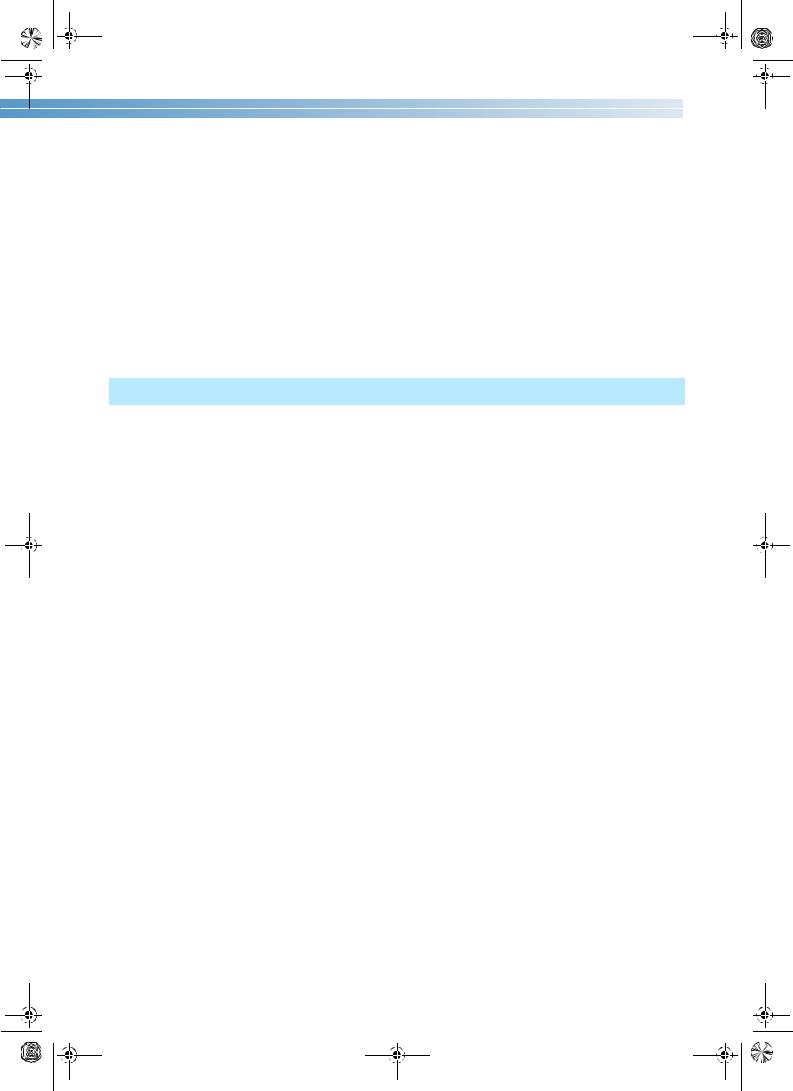
S3_brotherE.book Page 5 Wednesday, February 12, 2003 11:49 AM
Decorative Stitching ........................................................................................................ |
100 |
Fagoting ........................................................................................................................................................ |
101 |
Scallop stitching ............................................................................................................................................ |
102 |
Smocking ...................................................................................................................................................... |
102 |
Shell tuck stitching ........................................................................................................................................ |
103 |
Joining .......................................................................................................................................................... |
104 |
Heirloom stitching ........................................................................................................................................ |
105 |
Sewing the Various Built-In Decorative Patterns ............................................................. |
108 |
Sewing beautiful patterns .............................................................................................................................. |
108 |
Sewing patterns ............................................................................................................................................. |
108 |
Combining patterns ....................................................................................................................................... |
109 |
Repeat sewing patterns .................................................................................................................................. |
110 |
Checking the selected pattern ....................................................................................................................... |
111 |
Changing the pattern length .......................................................................................................................... |
111 |
Mirror imaging the pattern ............................................................................................................................ |
112 |
Storing a pattern ............................................................................................................................................ |
113 |
Realigning the pattern ................................................................................................................................... |
114 |
APPENDIX ..................................................................................................... |
117 |
Stitch Settings .................................................................................................................. |
118 |
Utility stitches ............................................................................................................................................... |
118 |
Other stitches ................................................................................................................................................ |
123 |
Maintenance .................................................................................................................... |
124 |
Cleaning the machine surface ....................................................................................................................... |
124 |
Cleaning the shuttle ...................................................................................................................................... |
124 |
Troubleshooting .............................................................................................................. |
126 |
Error messages .............................................................................................................................................. |
130 |
Nothing appears in the LCD .......................................................................................................................... |
131 |
Operation beep ............................................................................................................................................. |
131 |
Cancelling the operation beep ...................................................................................................................... |
132 |
Index ............................................................................................................................... |
133 |
5
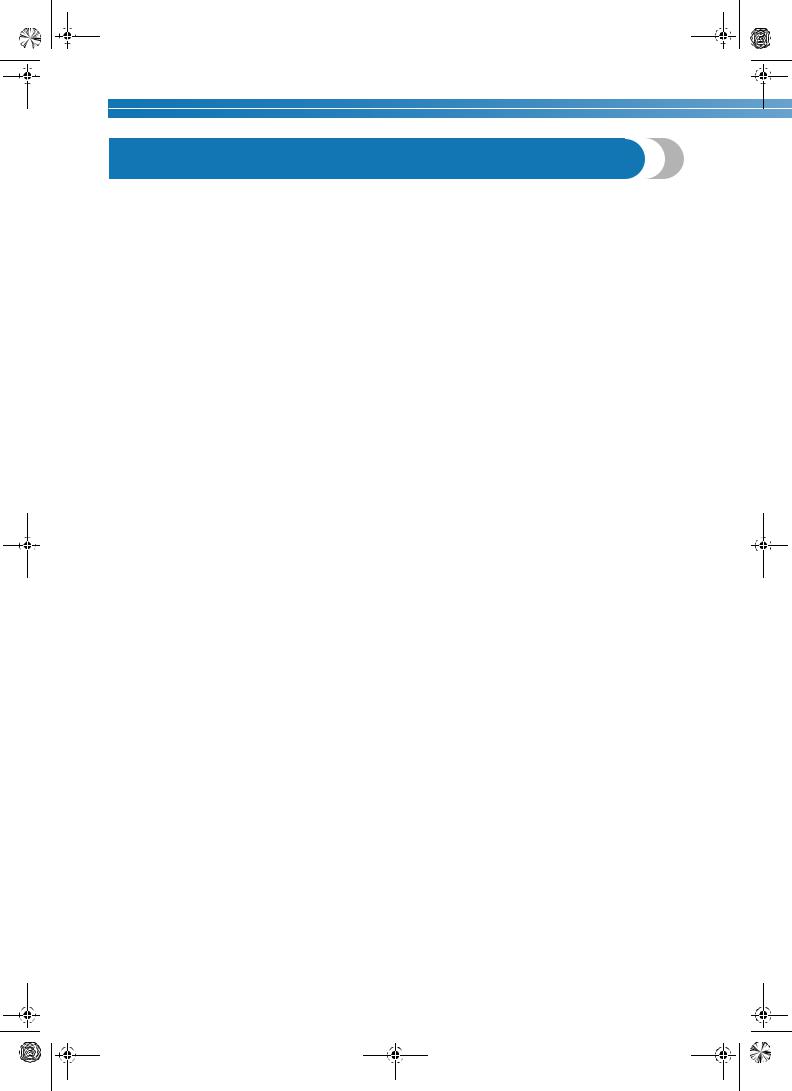
S3_brotherE.book Page 6 Wednesday, February 12, 2003 11:49 AM
Important Safety Instructions
When using this machine, basic safety precautions should always be taken, including the following:
Read all instructions before using.
DANGER - To reduce the risk of electric shock:
1.The machine should never be left unattended while plugged in. Always unplug the machine from the electrical outlet immediately after using and before cleaning.
WARNING - To reduce the risk of burns, fire, electric shock, or injury to persons:
1.Do not allow this machine to be used as a toy. Close attention is necessary when the machine is used by or near children.
2.Use this machine only for its intended use as described in this manual. Use only accessories recommended by the manufacturer as contained in this manual.
3.Never operate this machine if it has a damaged cord or plug, if it is not working properly, if it has been dropped or damaged, or dropped into water. Return the machine to the nearest authorized dealer or service center for examination, repair, electrical or mechanical adjustment.
4.Never operate the machine with any air openings blocked. Keep ventilation openings of the machine and foot control free from the accumulation of lint, dust, and loose cloth.
5.Never drop or insert any object into any opening.
6.Do not use outdoors.
7.Do not operate where aerosol (spray) products are being used or where oxygen is being administered.
8.To disconnect, turn the main switch to the symbol “{” position which represents off, then remove plug from outlet.
9.Do not unplug by pulling on cord. To unplug, grasp the plug, not the cord.
10.Keep fingers away from all moving parts. Special care is required around the machine needle.
11.Always use the proper needle plate. The wrong plate can cause the needle to break.
12.Do not use bent needles.
13.Do not pull or push fabric while stitching. It may deflect the needle causing it to break.
14.Switch the machine to the symbol “{” position when making any adjustments in the needle area, such as threading needle, changing needle, threading bobbin, or changing presser foot, and the like.
15.Always unplug the machine from the electrical outlet when removing covers, lubricating, or when making any other user servicing adjustments mentioned in the instruction manual.
16.This sewing machine is not intended for use by young children or infirm persons without supervision.
17.Young children should be supervised to ensure that they do not play with this machine.
18.If the Light unit is damaged, it must be replaced by authorized dealer.
SAVE THESE INSTRUCTIONS
This machine is intended for household use.
6
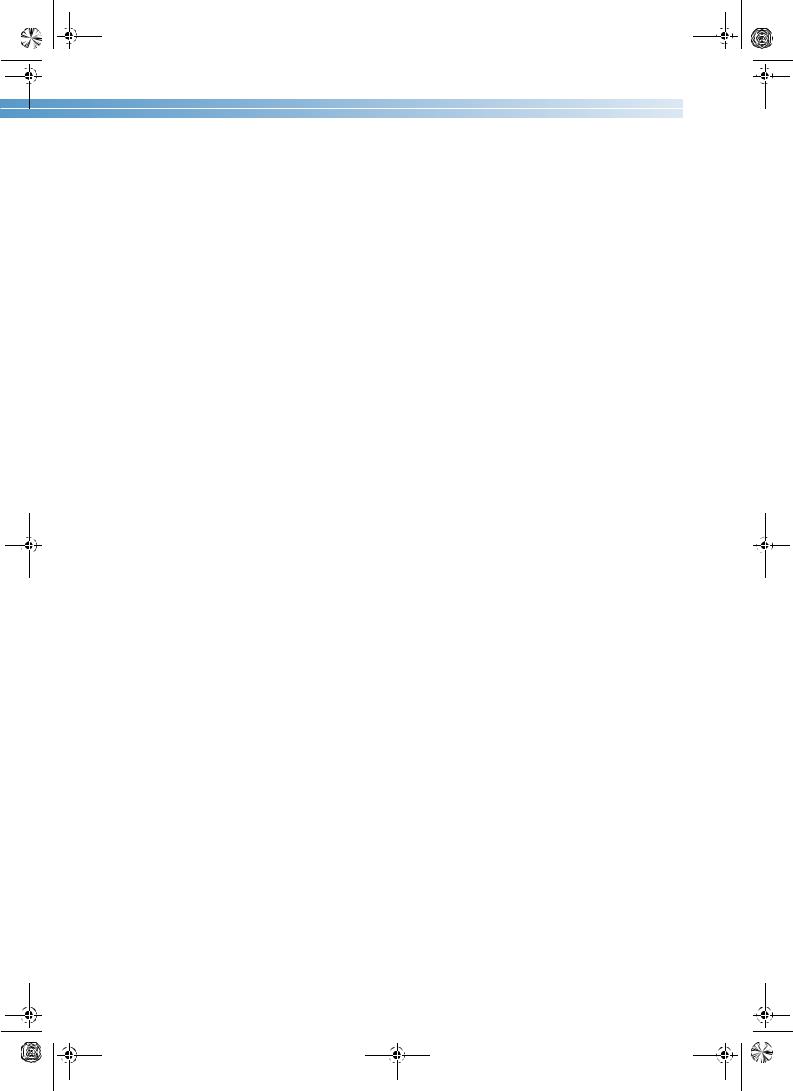
S3_brotherE.book Page 7 Wednesday, February 12, 2003 11:49 AM
FOR USERS IN THE UK, EIRE, MALTA AND CYPRUS ONLY
If this machine is fitted with a three-pin non-rewireable BS plug then please read the following.
IMPORTANT
If the available socket outlet is not suitable for the plug supplied with this equipment, it should be cut off and an appropriate three-pin plug fitted. With alternative plugs an approved fuse must be fitted in the plug.
NOTE
The plug served from the main lead must be destroyed as a plug with bared flexible cords is hazardous if engaged in a live socket outlet. In the event of replacing the plug fuse, use a fuse approved by ASTA to BS 1362, i.e. carrying the  mark, rating as marked on plug. Always replace the fuse cover, never use plugs with the fuse cover omitted.
mark, rating as marked on plug. Always replace the fuse cover, never use plugs with the fuse cover omitted.
WARNING
DO NOT CONNECT EITHER WIRE TO THE EARTH TERMINAL WHICH IS MARKED WITH THE LETTER ‘E’, BY THE EARTH SYMBOL  OR COLOURED GREEN OR GREEN AND YELLOW.
OR COLOURED GREEN OR GREEN AND YELLOW.
The wires in this main lead are colored in accordance with the following code:
Blue Neutral
Brown Live
As the colors of the wiring in the main lead of this appliance may not correspond with the colored markings identifying the terminals in your plug, proceed as follows.
The wire which is colored blue must be connected to the terminal which is marked with the letter ‘N’ or colored black or blue.
The wire which is colored brown must be connected to the terminal which is marked with the letter ‘L’ or colored red or brown.
7

S3_brotherE.book Page 8 Wednesday, February 12, 2003 11:49 AM
CONGRATULATIONS ON CHOOSING OUR MACHINE
Your machine is one of the most advanced computerized household sewing machines. To fully enjoy all the features, we suggest that you study the manual before using the machine.
PLEASE READ BEFORE USING THIS MACHINE
For safe operation
1.Be sure to keep your eye on the needle while sewing. Do not touch the hand wheel, thread takeup lever, needle, or other moving parts.
2.Remember to turn off the power switch and unplug the cord when:
•Operation is completed
•Replacing or removing the needle or any other parts
•A power failure occurs during use
•Maintaining the machine
•Leaving the machine unattended
3.Do not store anything on the foot controller.
4.Plug the machine directly into the wall. Do not use extension cords.
For a longer service life
1.When storing this machine, avoid direct sunlight and high humidity locations. Do not use or store the machine near a space heater, iron, halogen lamp, or other hot objects.
2.Use only neutral soaps or detergents to clean the case. Benzene, thinner, and scouring powders can damage the case and machine, and should never be used.
3.Do not drop or hit the machine.
4.Always consult the operation manual when replacing or installing any assemblies, the presser feet, needle, or other parts to assure correct installation.
For repair or adjustment
In the event a malfunction occurs or adjustment is required, first follow the troubleshooting table in the back of the operation manual to inspect and adjust the machine yourself. If the problem persists, please consult your local authorized Brother dealer.
For additional product information and updates, visit our web site at www.brother.com
8
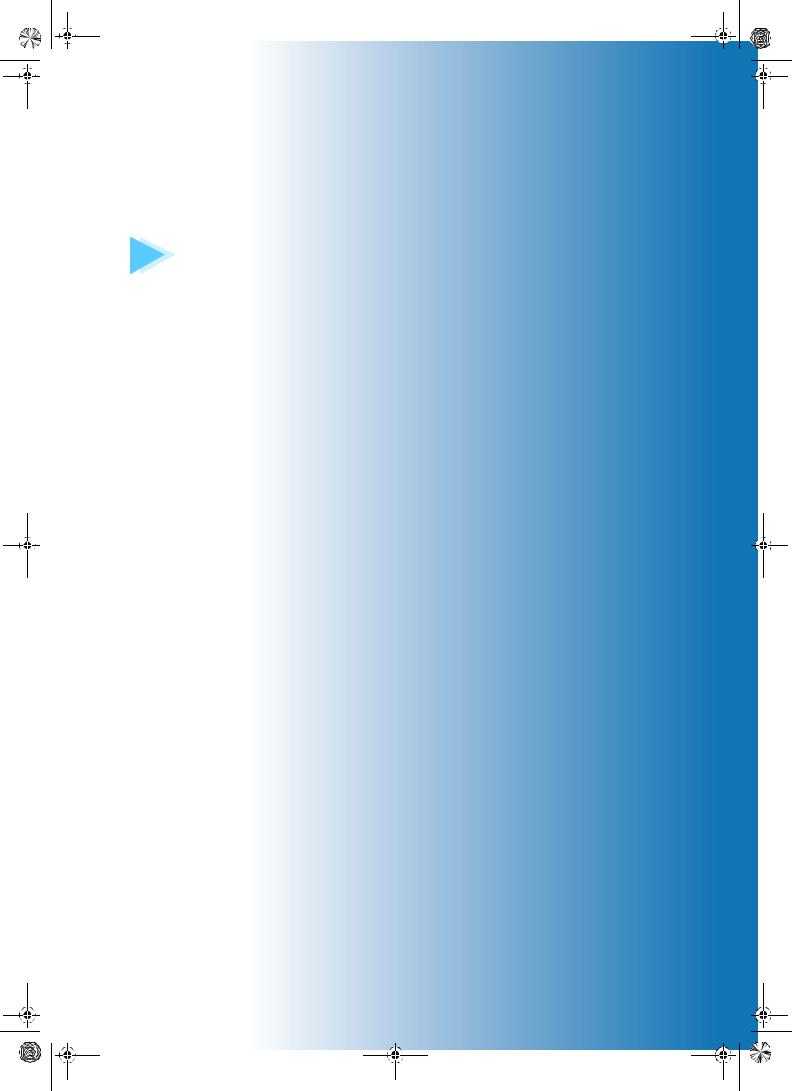
S3_brotherE.book Page 9 Wednesday, February 12, 2003 11:49 AM
1 GETTING READY
The various preparations required before starting to sew are described in this chapter.
Turning the Machine On/Off ................................................................................. |
10 |
Understanding the LCD Screens ............................................................................. |
12 |
Changing the Machine Settings .............................................................................. |
14 |
Winding/Installing the Bobbin ............................................................................... |
18 |
Upper Threading .................................................................................................... |
24 |
Replacing the Needle ............................................................................................. |
36 |
Replacing the Presser Foot ..................................................................................... |
41 |
Sewing Cylindrical Pieces....................................................................................... |
46 |
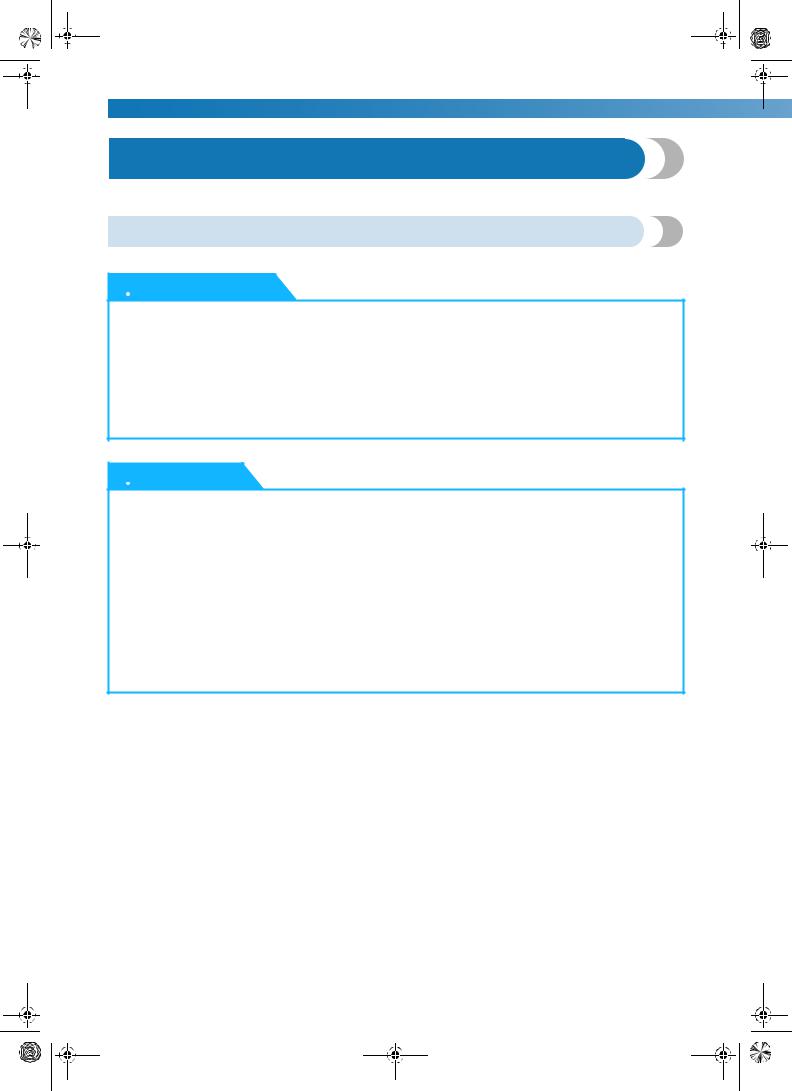
S3_brotherE.book Page 10 Wednesday, February 12, 2003 11:49 AM
GETTING READY ———————————————————————————————————————————————————————
Turning the Machine On/Off
This section explains how to turn the sewing machine on and off.
Power supply precautions
Be sure to observe the following precautions concerning the power supply.

 WARNING
WARNING
●Use only regular household electricity for the power source. Using other power sources may result in fire, electric shock, or damage to the machine.
●Turn off the main power and remove the plug in the following circumstances:
•When you are away from the machine
•After using the machine
•When the power fails during use
•When the machine does not operate correctly due to a bad connection or a disconnection
•During electrical storms

 CAUTION
CAUTION
●Do not use extension cords or multi-plug adapters with many other appliances plugged in to them. Fire or electric shock may result.
●Do not touch the plug with wet hands. Electric shock may result.
●When unplugging the machine, always turn off the main power first. Always grasp the plug to remove it from the outlet. Pulling on the cord may damage the cord, or lead to fire or electric shock.
●Do not allow the power cord to be cut, damaged, modified, forcefully bent, pulled, twisted, or bundled. Do not place heavy objects on the cord. Do not subject the cord to heat. These things may damage the cord and cause fire or electric shock. If the cord or plug is damaged, take the machine to your authorized dealer for repairs before continuing use.
●Unplug the power cord if the machine is not to be used for a long period of time. Otherwise a fire may result.
10
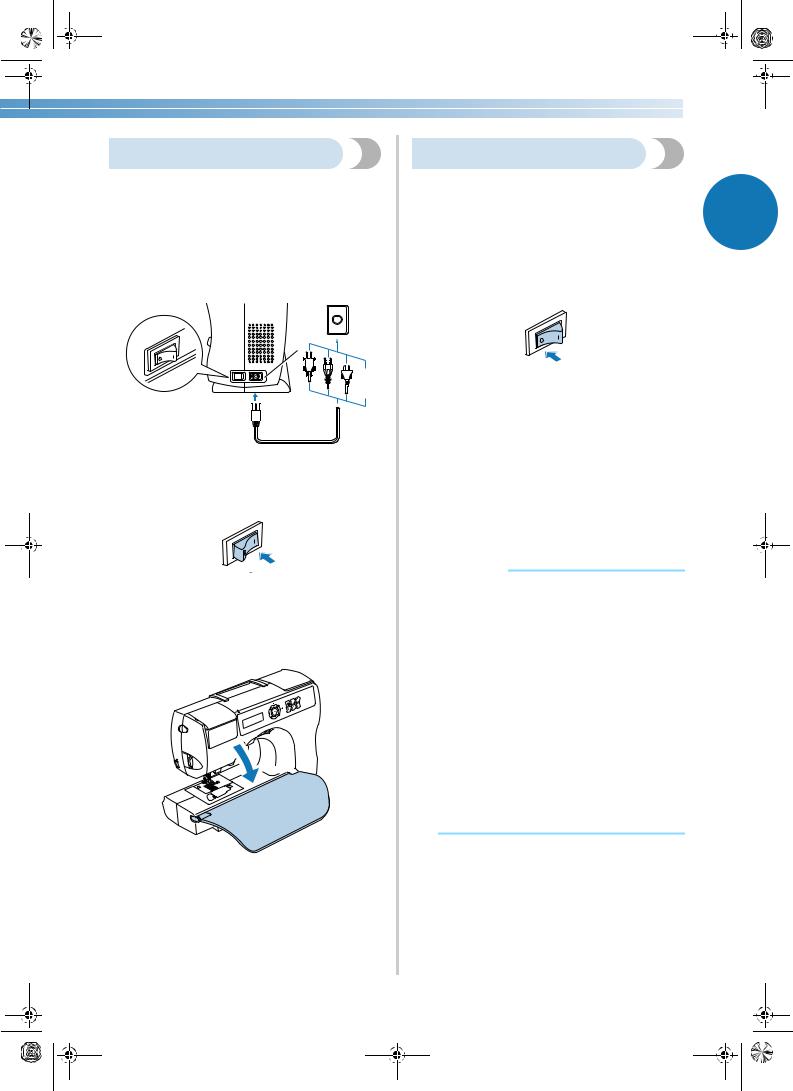
S3_brotherE.book Page 11 Wednesday, February 12, 2003 11:49 AM
Turning on the machine
1Make sure that the sewing machine is turned off (the main power switch is set to “O”), and then plug the power supply cord into the power supply jack on the right side of the machine.
2Insert the plug of the power supply cord into a household electrical outlet.
1
1 Power supply jack
3Press the right side of the main power switch on the right side of the machine (set it to “|”).
XThe sewing lamp comes on when the machine is turned on.
4Fold the flap at the front of the sewing machine down toward you.
Turning off the machine
When you are finished using the sewing machine, turn it off. In addition, before transporting the sewing
machine to another location, be sure to turn it off. |
1 |
|
1Make sure that the machine is not sewing.
2Press the left side of the main power switch on the right side of the machine (set it to “{”).
XThe sewing lamp goes off when the machine is turned off.
3Unplug the power supply cord from the electrical outlet.
Grasp the plug when unplugging the power supply cord.
4Unplug the power supply cord from the power supply jack.
 Note
Note
●If a power outage occurs while the sewing machine is being operated, turn off the sewing machine and unplug the power supply cord. When restarting the sewing machine, follow the necessary procedure to correctly operate the machine.
(For U.S.A only)
●This appliance has a polarized plug (one blade wider than the other). To reduce the risk of electrical shock, this plug is intended to fit in a polarized outlet only one way. If the plug does not fit fully in the outlet, reverse the plug. If it still does not fit, contact a qualified electrician to install the proper outlet. Do not modify the plug in any way.
Turning the Machine On/Off 11

S3_brotherE.book Page 12 Wednesday, February 12, 2003 11:49 AM
GETTING READY ———————————————————————————————————————————————————————
Understanding the LCD Screens
The LCD screen, located on the front of the sewing machine, displays the settings for the selected stitch and error messages if operations are performed incorrectly.
When the sewing machine is turned on, the LCD comes on and the following screen appears.
13
2 |
|
|
|
|
4 |
|
|
|
|||
|
|
|
|
|
5 |
|
|
|
|
|
1 Presser foot that should be used
2 Single or twin needle
3 Selected stitch
4 Stitch length (mm)
5 Stitch width (mm)
 Memo
Memo
●For details on the error messages that appear when an operation is performed incorrectly, refer to “Error messages” (page 130).
12
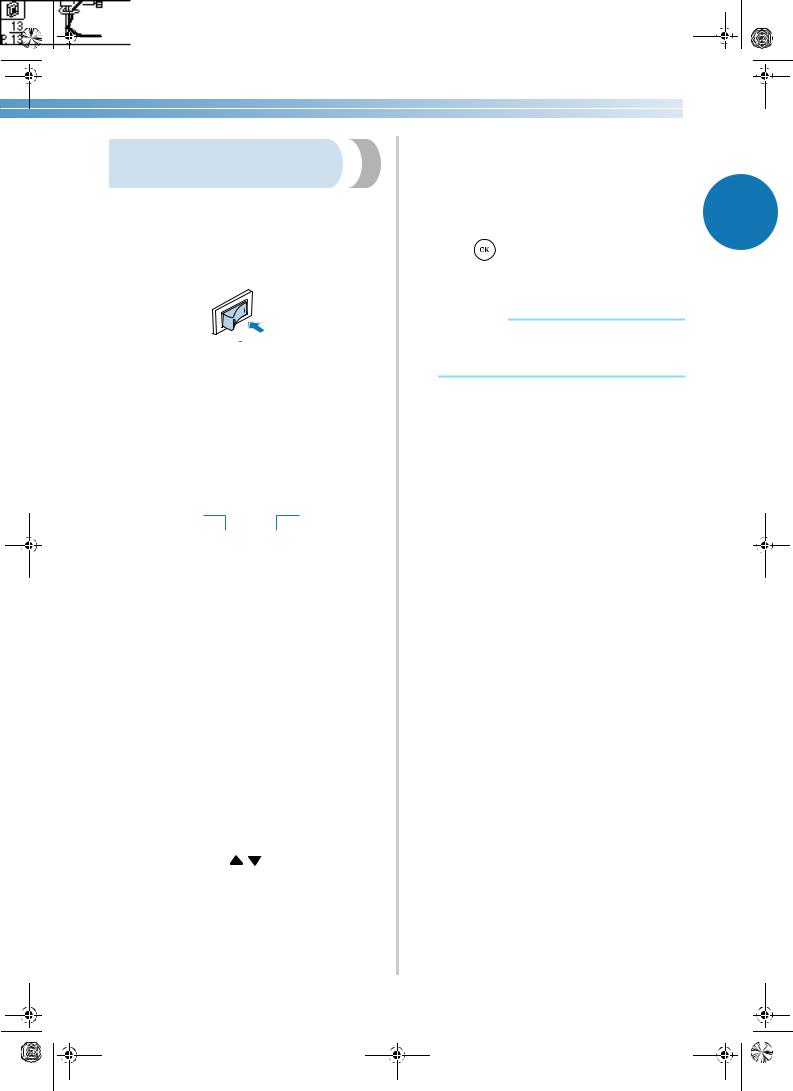
S3_brotherE.book Page 13 Wednesday, February 12, 2003 11:49 AM
Checking machine operating |
|
|
procedures |
|
|
Simple descriptions on replacing the presser foot, |
|
1 |
threading the upper thread, winding the bobbin and |
|
|
installing the bobbin can be displayed in the LCD. |
When you are finished with the help screen, |
|
1Turn on the sewing machine. |
6press |
(OK key). |
X The initial stitch screen appears again. |
||
 Note
Note
● For details on each topic, refer to the corresponding page in this Operation Manual.
X The LCD comes on.
2Press  (sewing machine help key) in the operation panel.
(sewing machine help key) in the operation panel.
X The sewing machine help screen appears.
3Press  ,
,  ,
,  and
and  (arrow keys) until the image illustrating desired topic is selected.
(arrow keys) until the image illustrating desired topic is selected.
12
3
 4
4
1 Replacing the presser foot
2 Threading the upper thread
3 Winding the bobbin
4 Installing the bobbin
4Press  (OK key).
(OK key).
XThe first screen describing the procedure for the selected topic appears.
5To display the next screen, press  . To return to the previous screen, press
. To return to the previous screen, press  .
.
Example: Upper threading
Understanding the LCD Screens 13

S3_brotherE.book Page 14 Wednesday, February 12, 2003 11:49 AM
GETTING READY ———————————————————————————————————————————————————————
Changing the Machine Settings
Various sewing machine operations and sewing settings can be changed.
Changing the settings
The general procedure for changing machine settings is described below.
1Turn on the sewing machine.
X The LCD comes on.
2Presspanel. (settings key) in the operation
(settings key) in the operation
X The settings screen appears.
3Press  ,
,  ,
,  and
and  (arrow keys) until the stitch or machine attribute that you wish to set is selected.
(arrow keys) until the stitch or machine attribute that you wish to set is selected.
4Press  (OK key).
(OK key).
XA screen containing settings for the selected attribute appears.
5Press  ,
,  ,
,  and
and  (arrow keys) until the desired setting is selected.
(arrow keys) until the desired setting is selected.
X The setting is changed.
6Press  (OK key).
(OK key).
X The initial stitch screen appears again.
14
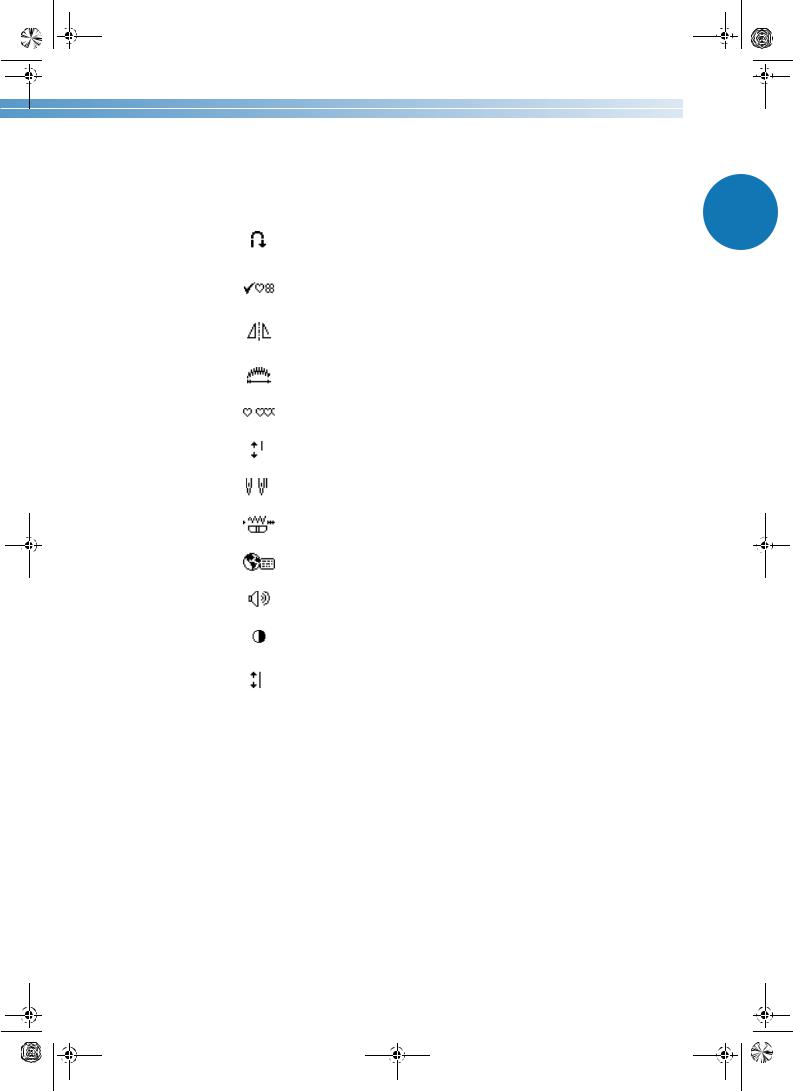
S3_brotherE.book Page 15 Wednesday, February 12, 2003 11:49 AM
■List of stitch or machine attributes
The stitch or machine attributes that can be set are listed below. For details on each attribute, refer to the corresponding reference page.
Attribute |
Icon |
Details |
Reference |
1 |
|
|
|
|
|
Automatic |
|
|
|
|
reverse/ |
|
Specifies automatic reverse/reinforcement stitching. |
page 59 |
|
reinforcement |
|
|
||
|
|
|
|
|
stitching |
|
|
|
|
|
|
|
|
|
Check |
|
Allows combined patterns to be checked. |
page 109 |
|
pattern |
|
|
||
|
|
|
|
|
|
|
|
|
|
Left/right |
|
|
|
|
mirror |
|
Mirror images patterns along a vertical axis. |
page 112 |
|
imaging |
|
|
|
|
|
|
|
|
|
Pattern |
|
Adjusts the length of satin stitches. |
page 111 |
|
length |
|
|
||
|
|
|
|
|
|
|
|
|
|
Repeated/ |
|
Specifies whether the pattern will be sewn once or |
page 110 |
|
single sewing |
|
repeatedly. |
|
|
|
|
|
||
|
|
|
|
|
Needle |
|
Specifies where the needle is positioned when the |
page 16 |
|
position |
|
sewing machine is stopped. |
|
|
|
|
|
||
|
|
|
|
|
Twin needle |
|
Specifies the twin needle. |
page 32 |
|
sewing |
|
|
||
|
|
|
|
|
|
|
|
|
|
Stitch width |
|
Allows the stitch width to be adjusted with the |
page 94 |
|
control |
|
sewing speed controller. |
|
|
|
|
|
||
|
|
|
|
|
Language |
|
Allows the language used in the screens to be |
page 17 |
|
|
changed. |
|
||
|
|
|
|
|
|
|
|
|
|
Buzzer |
|
Specifies whether or not a beep is sounded with |
page 130 |
|
|
each operation. |
|
||
|
|
|
|
|
|
|
|
|
|
LCD |
|
Adjusts the brightness of the LCD. |
page 16 |
|
brightness |
|
|
||
|
|
|
|
|
|
|
|
|
|
Vertical |
|
|
|
|
pattern |
|
Adjusts the up and down position of the pattern. |
page 114 |
|
adjustment |
|
|
|
|
|
|
|
|
|
Changing the Machine Settings 15
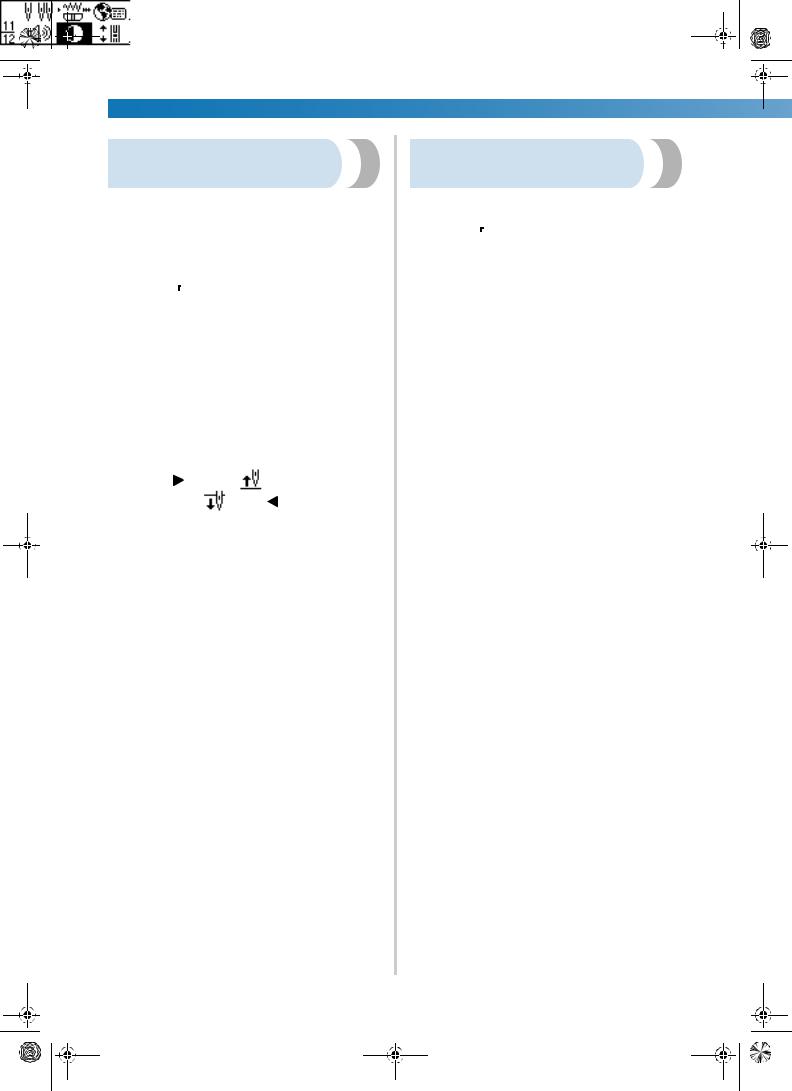
S3_brotherE.book Page 16 Wednesday, February 12, 2003 11:49 AM
GETTING READY ———————————————————————————————————————————————————————
Changing the needle stop position
When the sewing machine is purchased, it is set to leave the needle lowered in the fabric when sewing is stopped. However, the machine can be set to instead leave the needle raised when sewing is stopped.
1Press  (settings key) in the operation panel, and then press
(settings key) in the operation panel, and then press  ,
,  ,
,  and
and  (arrow keys) until
(arrow keys) until  is selected.
is selected.
2Press  (OK key).
(OK key).
XThe screen for changing the needle stop position appears.
3Press |
to select |
. |
|
To return to |
, press |
. |
|
XThe machine is now set to stop with the needle in the raised position.
4Press  (OK key).
(OK key).
X The initial stitch screen appears again.
Adjusting the brightness of the LCD
The brightness of the LCD can be adjusted.
1Press  (settings key) in the operation panel, and then press
(settings key) in the operation panel, and then press  ,
,  ,
,  and
and  (arrow keys) until
(arrow keys) until  is selected.
is selected.
2Press  (OK key).
(OK key).
XThe screen for changing the brightness of the LCD appears.
3To make the LCD brighter, press  (–). To make the LCD darker, press
(–). To make the LCD darker, press  (+).
(+).
X The brightness of the LCD is changed.
4Press  (OK key).
(OK key).
X The initial stitch screen appears again.
16

S3_brotherE.book Page 17 Wednesday, February 12, 2003 11:49 AM
Changing the screen |
|
language |
|
The language used in the screens that are displayed |
1 |
can be changed to one of the many available. |
1Press  (settings key) in the operation panel, and then press
(settings key) in the operation panel, and then press  ,
,  ,
,  and
and  (arrow keys) until
(arrow keys) until  is selected.
is selected.
2Press  (OK key).
(OK key).
XThe screen for changing the language of the screens appears.
Press |
or |
until the desired language is |
3selected. |
|
|
The language can be changed to one of the available: English, French, German, Dutch, Spanish, Italian, Danish, Norwegian, Finnish, Swedish, Portuguese, Russian, Japanese, Korean or others.
X The language of the screens is changed.
4Press  (OK key).
(OK key).
X The initial stitch screen appears again.
Changing the Machine Settings 17

S3_brotherE.book Page 18 Wednesday, February 12, 2003 11:49 AM
GETTING READY ———————————————————————————————————————————————————————
Winding/Installing the Bobbin
This section describes how to wind the thread onto the bobbin, and then insert the bobbin thread.
Bobbin precautions
Be sure to observe the following precautions concerning the bobbin.

 CAUTION
CAUTION
●Only use the bobbin (part code: SA156, XA5539-151) designed specifically for this sewing machine. Use of any other bobbin may result in injuries or damage to the machine.
●The enclosed bobbin was designed specifically for this sewing machine. If bobbins from older models are used, the machine will not operate correctly. Use only the enclosed bobbin or bobbins of the same type (part code: SA156, XA5539-151).
Actual size
11.5 mm (7/16 inch)
This model |
Older model |
|
|
Winding the bobbin
Wind the thread around the bobbin to prepare the bobbin thread.
1Turn on the sewing machine. |
3 |
2Open the bobbin winder cover at the top on the right side of the sewing machine.
4
18
Swing up the bobbin thread spool pin.
Move the bobbin thread spool pin up as far as possible.
1
1 Bobbin thread spool pin
Place the bobbin on the bobbin winder shaft so that the spring on the shaft fits into the notch in the bobbin.
1
2
1 Notch
2 Bobbin winder shaft spring
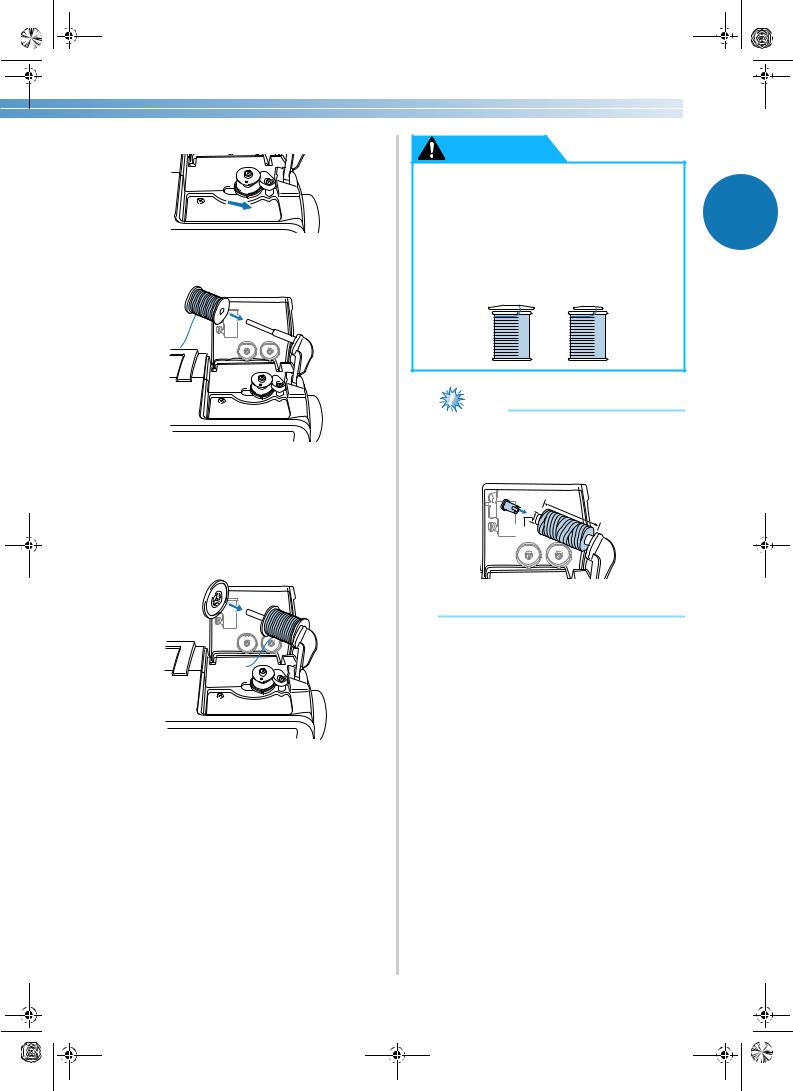
S3_brotherE.book Page 19 Wednesday, February 12, 2003 11:49 AM
5Slide the bobbin winder shaft to the right. |
CAUTION |
● Two spool cap sizes are available, allowing you to choose a spool cap that
best fits the size of spool being used. If 1 the spool cap is too small for the spool
being used, the thread may catch on the
6Place the spool of thread for the bobbin onto slit in the spool or the needle may break. the bobbin thread spool pin. 
|
Note |
|
|
● If a spool of thread 12 mm (1/2 inch) in |
|
|
diameter and 75 mm (3 inch) high is |
|
Slide the spool cap onto the bobbin thread |
inserted onto the bobbin thread spool pin, |
|
use the special spool cap. |
||
7spool pin. |
|
|
With the rounded side of the spool cap |
2 |
|
positioned toward the left, slide the spool cap |
||
|
||
onto the bobbin thread spool pin as far as |
1 |
|
possible until the right side of the spool |
||
|
||
touches the right end of the bobbin thread |
|
|
spool pin. |
|
|
|
1 12 mm (1/2 inch) |
|
|
2 75 mm (3 inch) |
Winding/Installing the Bobbin 19
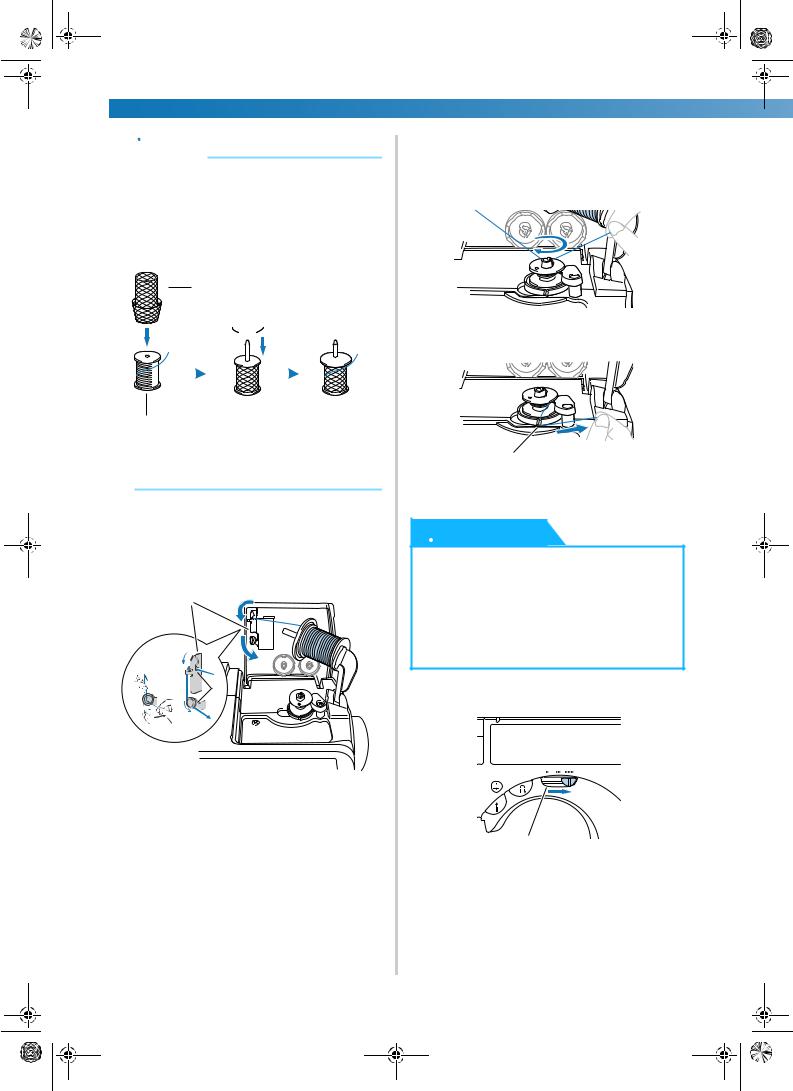
S3_brotherE.book Page 20 Wednesday, February 12, 2003 11:49 AM
GETTING READY ———————————————————————————————————————————————————————
 Memo
Memo
●When using thread that winds off quickly, such as transparent nylon thread or metallic thread, place the enclosed spool net over the spool before placing the spool of thread onto the spool pin.
If the spool net is too long, fold it to fit the size of the spool.
1

 4
4
3

2
1 Spool net
2 Spool
3 Spool pin
4 Spool cap
8Pull out some thread, and then thread the thread guide for bobbin winding.
Hold the thread with both hands, and then securely pass the thread as far as possible into the two slits in the thread guide.
1
2
1 Thread guide for bobbin winding
2 Two slits
9While using your left hand to hold the end of the thread that wraps around the thread guide for bobbin winding, use your right hand to wind the free end of the thread clockwise around the bobbin five or six times.
0Pull the thread to the right and pass it through the slit in the bobbin winder seat.
1
1 Slit in bobbin winder seat (with built-in cutter)
X The thread is cut to a suitable length.
 CAUTION
CAUTION
●Be sure to cut the thread as described. If the bobbin is wound without cutting the thread using the cutter built into the slit in the bobbin winder seat, the thread may become tangled in the bobbin or the needle may bend or break when the bobbin thread starts to run out.
aSlide the sewing speed controller to the right
(so that the speed will be fast).
1
1 Sewing speed controller
20
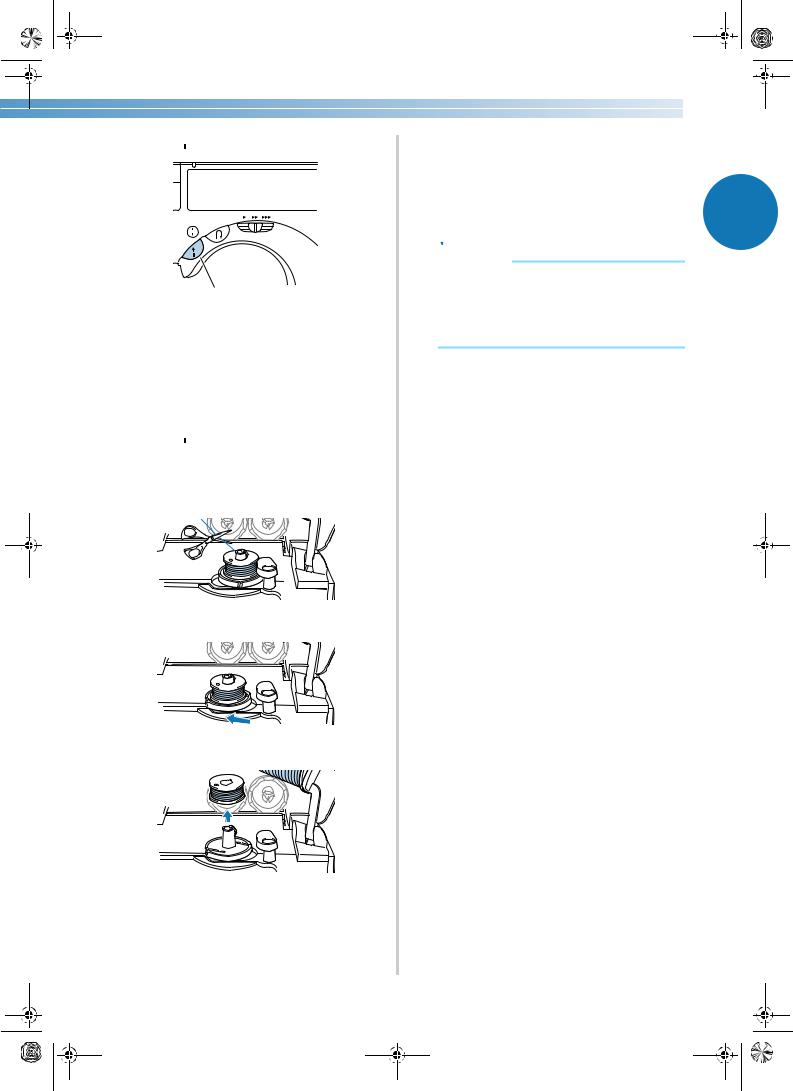
S3_brotherE.book Page 21 Wednesday, February 12, 2003 11:49 AM
bPress  (start/stop button) once.
(start/stop button) once.
1
1 Start/stop button
XThe bobbin starts spinning and the thread is wound around the bobbin.
XThe bobbin spins slowly when it is full.
cWhen the bobbin begins spinning slowly, Press  (start/stop button) once.
(start/stop button) once.
X The sewing machine stops.
dUse scissors to cut the end of the thread wound around the bobbin.
gRemove the spool cap and spool.
hSwing down the bobbin thread spool pin, close the bobbin winder cover, and then slide the sewing speed controller back to its
original position. |
1 |
|
 Memo
Memo
●When the sewing machine is started or the balance wheel is turned after winding the thread around the bobbin, the machine will make a clicking sound; this is not a malfunction.
eSlide the bobbin winder shaft to the left.
fRemove the bobbin from the shaft.
Winding/Installing the Bobbin 21
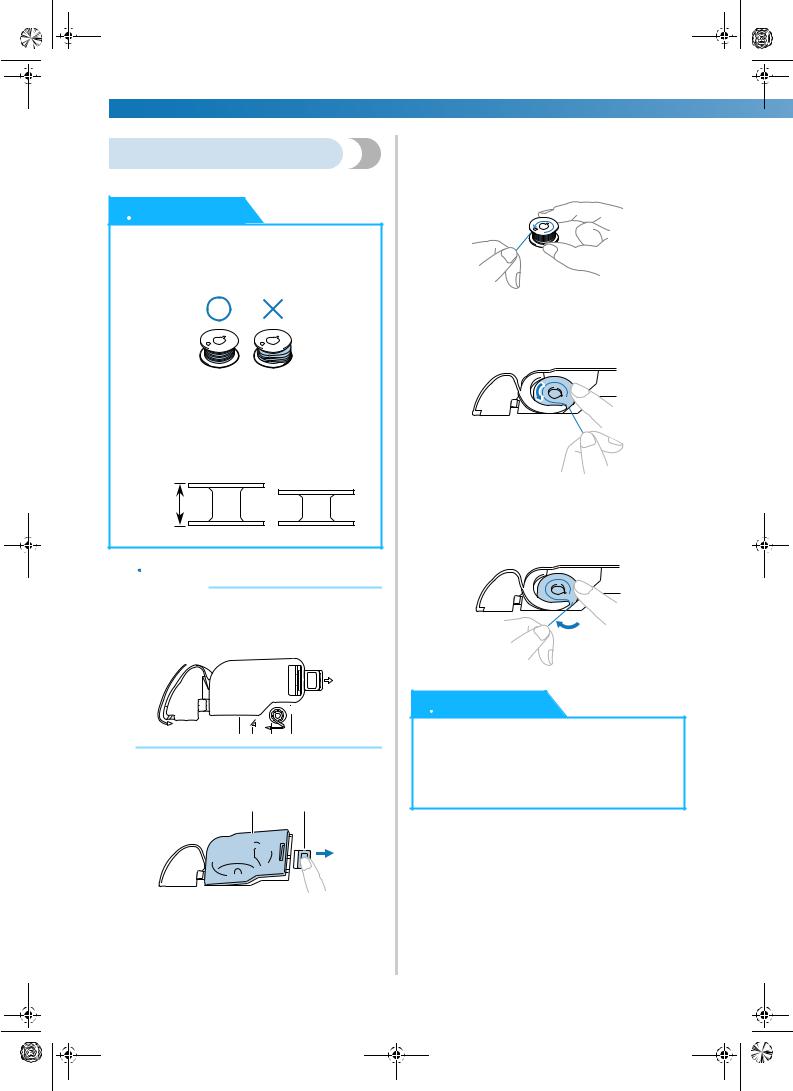
S3_brotherE.book Page 22 Wednesday, February 12, 2003 11:49 AM
GETTING READY ———————————————————————————————————————————————————————
Installing the bobbin
Install the bobbin wound with thread.

 CAUTION
CAUTION
●Use a bobbin thread that has been correctly wound, otherwise the needle may break or the thread tension will be incorrect.
●The bobbin was designed specifically for this sewing machine. If bobbins from older models are used, the machine will not operate correctly. Use only the enclosed bobbin or bobbins of the same type (part code: SA156, XA5539-151).
Actual size
11.5 mm (7/16 inch)
This model |
Older model |
 Memo
Memo
●The order that the bobbin thread should be passed through the needle plate is indicated by marks around the shuttle. Be sure to thread the machine as indicated.
1Slide the bobbin cover latch to the right.
1 2
2Remove the bobbin cover.
3Hold the bobbin with your right hand and hold the end of the thread with your left.
• Be careful not to drop the bobbin.
4Insert the bobbin into the shuttle so that the thread unrolls to the left.
• Be sure to insert the bobbin correctly.
5Lightly hold down the bobbin with your right hand, and then guide the thread as shown with your left hand.
 CAUTION
CAUTION
●Be sure to hold down the bobbin with your finger and unroll the bobbin thread correctly, otherwise the thread may break or the thread tension will be incorrect.
1 Bobbin cover
2 Latch
X The bobbin cover opens.
22
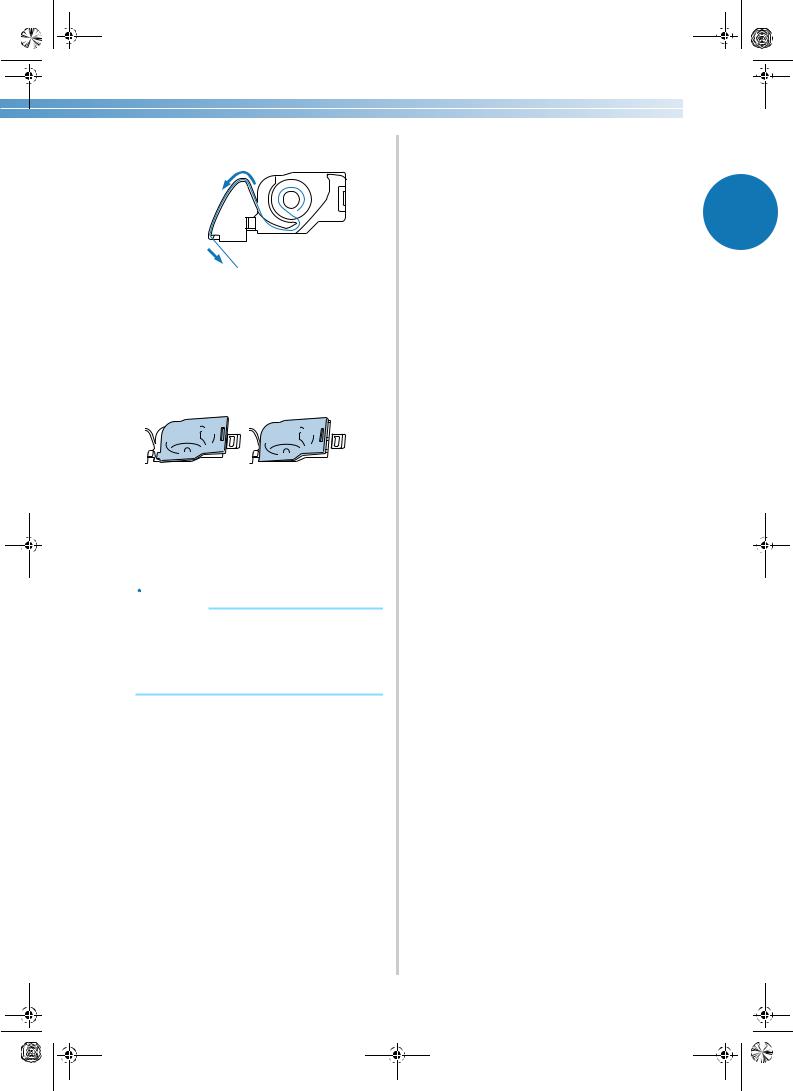
S3_brotherE.book Page 23 Wednesday, February 12, 2003 11:49 AM
6Pass the thread through the slot as shown, and then pull the thread out toward the front.
1
1 

1 Cutter
X The cutter cuts the thread.
7Reattach the bobbin cover.
Insert the tab in the lower-left corner of the bobbin cover, and then lightly press down on the right side.
 2
2
 1
1
X The lower threading is finished.
Next, thread the upper thread. Continue with the procedure in “Upper Threading” (on the next page).
 Memo
Memo
●You can begin sewing without pulling up the bobbin thread. If you wish to pull up the bobbin thread before starting to sew, pull up the thread according to the procedure in “Pulling up the bobbin thread” (page 35).
Winding/Installing the Bobbin 23
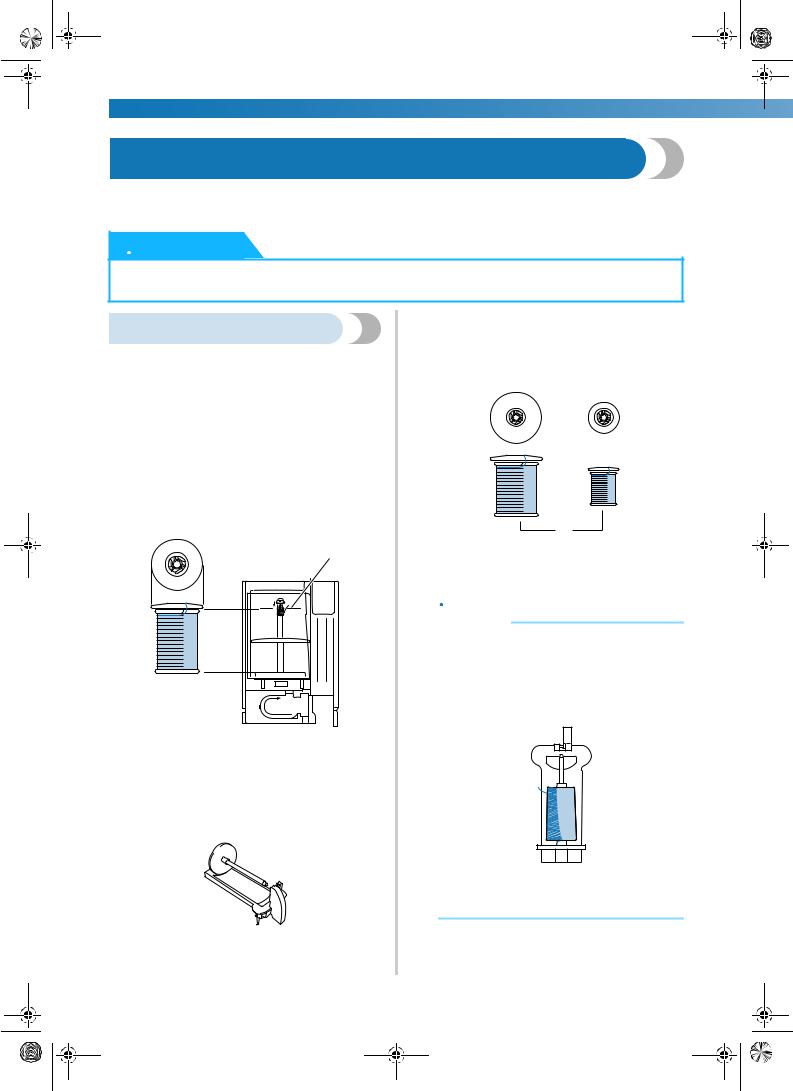
S3_brotherE.book Page 24 Wednesday, February 12, 2003 11:49 AM
GETTING READY ———————————————————————————————————————————————————————
Upper Threading
In this section, the procedures for positioning the spool for the upper thread and threading the needle are described.

 CAUTION
CAUTION
●When threading the upper thread, carefully follow the instructions. If the upper threading is not correct, the thread may become tangled or the needle may bend or break.
About the spool of thread
With this sewing machine, a spool of thread can be loaded into the enclosed thread cassette, and then the thread cassette can be threaded. Information about the spools of thread is described below.
■Spools that can be loaded into the thread cassette
Normally, a spool of thread is loaded into the thread cassette and used. The spools that can be loaded must have a diameter smaller than the orange spool cap and a height shorter than the mark on the cover of the thread cassette.
1
3
1
2
1 Spool cap (orange)
2 Spool
3Mark on thread cassette compartment cover
■Spools that cannot be loaded into the thread cassette
When using spools that cannot be loaded into the thread cassette, use the enclosed extra spool pin.
When using the extra spool pin, attach either the large or small white spool cap, depending on the size of the spool. Use the spool cap with a diameter that is slightly larger than the diameter of the spool.
1
2
3
1 Spool cap (large)
2 Spool cap (small)
3 Spool
 Memo
Memo
●For details on using the extra spool pin, refer to “Using the extra spool pin” (page 30).
●When using a spool of cross-wound thread, install the small white spool cap with some space between the cap and the spool.
1

 2
2
3

1 Spool cap (small)
2 Gap
3 Spool
24
